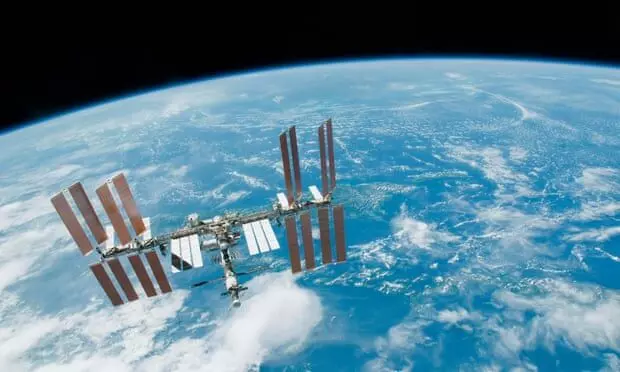
In 2030, the International Space Station will plunge into the sea
text_fieldsThe International Space Station backdropped by Earth's horizon and the blackness of space. Photograph: Stocktrek Images/Getty Images
During a new transition plan released this week, Nasa confirmed that the International Space Station (ISS) would continue its operations until 2030 before heading to a watery grave in the Pacific.
As per the estimates for the NASA budget, the ISS, launched in 1998, will be de-orbited in January 2031.
After leaving in orbit, the space station will make a dramatic descent before splashing down in Point Nemo, which is about 2,700km from any land and has become known as the space cemetery, a resting place for old satellites, decommissioned space stations, and other human space debris.
Known as the "Oceanic Pole of Inaccessibility" and the "South Pacific Ocean Uninhabited Area," the region around the space cemetery is renowned for its lack of human activity. According to NASA, "It's pretty much the farthest place from any human civilization one can find".
By buying space and time on commercial spacecraft, NASA plans to continue its space research in the future.
Robyn Gatens, director of the International Space Station at NASA Headquarters, celebrated the ISS's scientific accomplishments, but explained that its current goal is to "lay the groundwork for a commercial future in low-Earth orbit".
Phil McAlister, the director of commercial space at Nasa headquarters, stated that, "We look forward to sharing our lessons learned and operations experience with the private sector to help them develop safe, reliable and cost-effective destinations in space."
In its report, NASA estimated that Space research in 2031 would be cheaper and more efficient if they moved from a dedicated space station to commercial space ventures, allowing the agency to explore deep space faster and further.
Astronauts have continuously occupied the International Space Station (ISS) since November 2000. The ISS is about the size of a football field, orbiting the earth about every 90 minutes.
BBC News reported that a Russian official said cracks found on the international space station could get worse over time and raised concerns about aging equipment and the risk of "irreparable failures".
It was originally slated to operate for 15 years, but Nasa said in a report that "there is a high confidence that ISS life can be further extended through 2030", although some analyses about its viability are still continuing.
In its report, Nasa said that the ISS was investigating recent technical issues aboard the Russian segment.
A law review article on the space cemetery's environmental impact estimates that nearly 300 pieces of space debris, most of them American or Russian, have been sunk at Point Nemo since 1971.
The space station is likely to end in a fiery explosion. The Russian space station Mir plummeted toward earth in March 2001 after a cargo ship fired its engines to push it out of orbit.
Nasa documentation indicates that, As the space station fell, solar panels and other peripheral pieces were broken off, but about 20 to 25 tons of debris fell together, causing sonic booms.
























